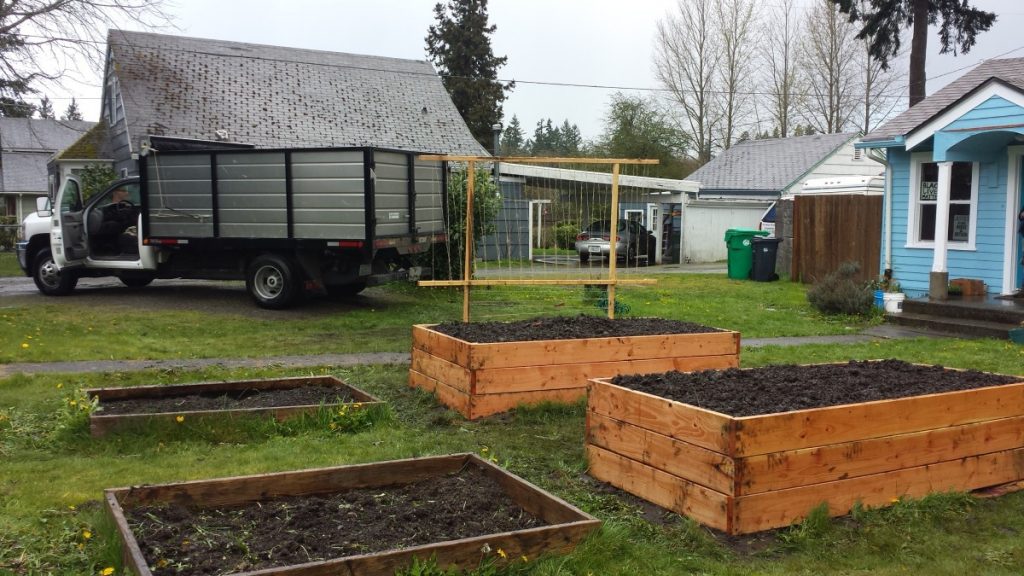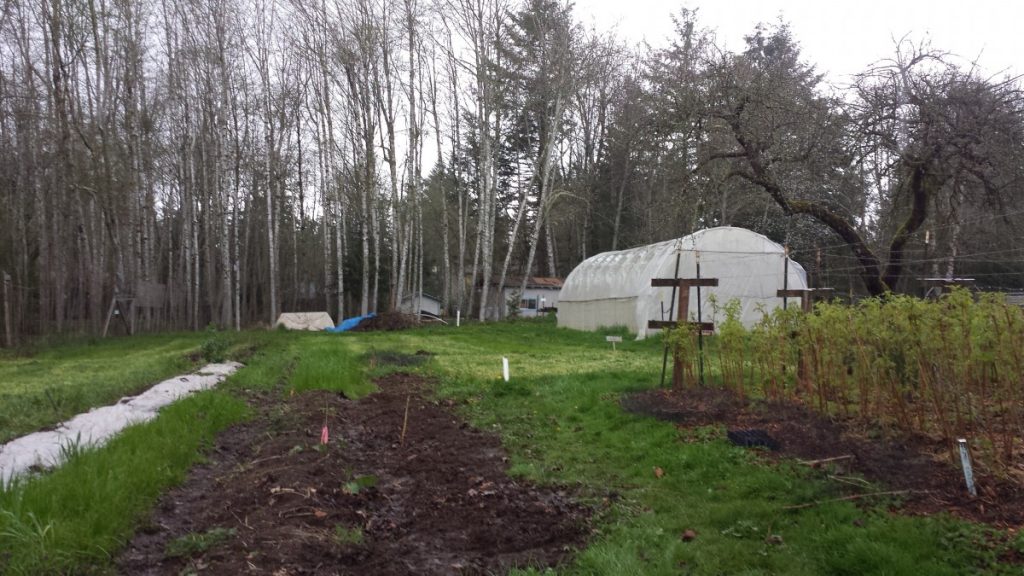Supposedly it is spring, but you almost can’t tell at GRuB’s farm. The fields are puddled up, the land swollen with the never ending rainy season. The greenhouses are still home to this winter’s cover crops and several varieties of de-licious spinach. The volunteer farm tasks have been limited to weeding and mulching paths for the most part. And just when you think there will be a break in the weather, another swarm of grey clouds rolls overhead.
Even still, signs of spring are all around us. New sprouts and buds are bursting from trees, and the sweet smell of apple blossoms greets you on the gentle breeze. The propagation house is home to hundreds of baby plants eager to dig there roots into the traditionally Squaxin tribal land. The dirt is full of worms and other decomposers, steadily breaking down the soil in preparation for this year’s new crops. The flock of hens is excitedly munching on grub and greens, producing more eggs than the farm house can transform into community meals!
Inside the farm house, Grubbers are turning up their activity levels as they emerge from the office to once again pollinate the community. A new wave of farm interns joined the team this month, bringing with them heightened levels of enthusiasm as they tend to the plant starts, prepare the land (weather permitting), clean out the cobwebs, and weed, weed, weed! The Victory Garden Project is out in the community building free raised garden beds to families in need. Rain or shine they deliver BIG.

The field trip program, where I have my roots this year, is in full swing. Although my first field trip was this week, several elementary groups have already gotten their hands dirty here at GRuB. The workshop programming we offer allows the young-ins to feed chickens and compare their eggs to store bought ones, to learn about and eat each of the six parts of a plant, to smell, taste and feel the power of medicinal herbs and to build compost and feel the heat of decomposing bugs’ farts!
The GRuB School Youth are gearing up for the season too, quite literally. They don yellow rain coats, boots and garden gloves as they begin their spring season rotating through the farm, the VGP builds and field trip program. This system allows them to gain hands-on experiential learning in three very important aspects of farming. At the end of the season, they will have learned farming techniques, how to build their own garden beds, and have a solid scientific understanding of the science behind the whole farming cycle.

By putting the high school youth in the leadership roles on these field trips, they are in essence stepping into a teaching role. They are presented with curriculum for one of the workshops, with learning objectives and a lesson plan built in. In each rotation, they have the chance to present 2-3 times. I’ve only witnessed week one of this rotation, in which several students resisted practicing and as a result felt they didn’t execute the workshop to the best of their ability. This is a huge lesson built into the format of the field trip program: there is value in practice and repetition. Even with just a few hours of practice, I saw each youth step up to fill their responsibilities in the roles they held. There were of course some hiccups, and with them came opportunities for growth.
The day following the field trip, we reflected on ourselves and the experience as a whole in a process known as straight talk. Combining affirmations with constructive feedback, each student, myself and my supervisor, wrote and shared what we observed in ourselves and others. I believe this style of debriefing is very fruitful, particularly with the youth, as they are practicing both self-affirmation and receiving more positive feedback than negative, something that is usually the opposite in a traditional education setting.
Personally, I was affirmed for the way in which I handled an allergic reaction that one of the visiting students had to an apple she ate that was contaminated with celery juice, to which she was rather allergic. Remaining calm, I worked with the teacher to find out procedure from the school as to whether or not we could provide an antihistamine, to locate them just in case, to call the parents and to tend to the needs of the child. What I noted for myself to focus on improving next time is an awareness of the group as a whole and attending to the needs of individuals while still maintaining the flow of the group.
I also received positive feedback for the support role I played to the GRuB youth as they lead the tours and workshops. They appreciated me stepping in when I noticed the students searching for what to say next or needing assistants in wrangling in the rowdy 2nd and 3rd graders. Striking this balance is my goal for the season and working with these high schoolers- to empower and support them without controlling situations or leaving them stranded in times of need.
One additional focus for the week was on the field trip program’s curriculum. I attended several meeting in which we discussed the proposed revamping of the field trip program. Although it won’t apply to this year’s fieldtrips, this much needed makeover is now underway. We will be collecting feedback from the youth and the teachers that attend our programming, attempting to find new ways of formatting the flow of the day as well as the individual workshops themselves.
My role is to reformat many of the documents used to introduce the youth to the program, to their roles, and to working with other youth in a leadership role. We are attempting to bring continuity and organization to these documents as well as the workshops. Each workshop will be reworked, combining a decade’s worth of information into fewer documents, and creating both easily accessible kits as well as age specific variations of each lesson. In concerted effort with my field supervisor, Katherine, and the head of the Seed to Table Program, Karen, a complete transformation of this program is underway!
The spring season ahead is shaping up to be full of a wide range of experiences at GRuB’s farm and beyond. As the life cycle changes from budding flower, to rich fruit, to potent seed, may we all grow, develop, and unfold in beautiful ways.
Be First to Comment